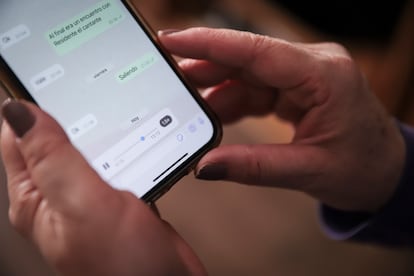Double-speed messages and videos: A time saver that can impact our memory
For years, it has been possible to play content at twice the speed to save time. But neurologists warn this can negatively affect memory, especially in the developmental stages of the brain

“I speed up the audio playback on platforms such as WhatsApp or Telegram. Also in certain YouTube video tutorials. I use it to get immediate answers, especially if it’s for work-related issues, to not waste time.” Those words were from 28-year-old Diego Ferraz, a creator of informative content on the climate crisis. Like many other social media users, when you find you do not have time to listen to an entire audio file or video, you select the option on your cell phone screen to speed it up. Do you take in all the information? “At 1.5x it’s easy, but at 1.75x or double the speed I sometimes have to go back,” he says. This trend of watching ― and now also hearing ― everything faster has become defined by the term “speedwatching,” and is increasingly common on all kinds of platforms, from instant messaging to Netflix, TikTok and Spotify. The use of this tool, neurologists warn, may affect short-term memory, although there is a lack of studies on its possible long-term effects.
On YouTube, it has been possible to speed up videos since 2010, but the real change came when WhatsApp, the most downloaded messaging platform in the world, incorporated this feature for audio playback in 2021. Now on social media platforms such as TikTok it is also possible to increase the playback speed. But it goes even further: Netflix and Amazon Prime allow you to watch audiovisual content at different speeds. According to Neal Mohan, YouTube’s product manager in 2022, its users saved “an average of more than 900 years of video time per day by watching at faster speeds.” Most surprisingly, he pointed out, they had even received requests to add triple or quadruple playback speeds.
Daniel Pazó, 27, uses this tool for certain academic courses, interviews and tutorials. “If the content is really long and I want to see something specific, this feature helps me to avoid watching a whole video,” he argues. “It would help in a lot in cases like with the average teacher who only reads PowerPoint.” The data backs this up: according to a 2021 University of California study, 85% of students sped up recorded lessons.
Short-term memory problems
But what might be the consequences of resorting to this sped-up form of content consumption? According to scientists, it is still too early to determine the exact extent. For Diego Redolar, professor of Neuroscience and vice-dean of Research at the Faculty of Psychology at the Universitat Oberta de Catalunya in Spain, there are risks and benefits. “When we listen to a message at a faster speed, we shorten the listening time, but we lose many of the aspects related to the message itself. In this regard, it is important to highlight prosody, which is the emotional way in which we interpret the message: the pauses, voice inflections, tone, and so on. Each video or audio file has a specific complexity that makes it unique. This is not to mention a cultural piece of work, such as a film, which is designed with silences,” stresses the professor, “which is processed by the amygdala in the brain and is very difficult to perceive if we speed it up.”
Increasing the playback speed of a piece of content can also serve to make the content suit your personal arrangements for the day. “If I have 30 minutes for lunch and I want to watch a 40-minute video, I switch it to 1.5 times the speed to give me time to watch it,” explains 26-year-old Roberto Estévez, a recent sociology graduate. He says he watches documentaries on YouTube and even consumes podcasts at a faster rate, but he does not quite pay as much attention to them as he would like to. “I feel like I don’t take in everything, but it’s usually empty content, so it doesn’t really matter. If I’m really interested in something, I go back and play it at normal speed,” he adds.
In this process of taking in a sped-up message, the brain tries to adapt as best it can. “It adapts to the information from the overall context of the message. This is where the prefrontal cortex works, and it is even positive to enhance it,” explains Redolar. However, the way language works is changing. “Instead of focusing on the analytical part and grasping the detail of the content, we focus on the overall part, in terms of a context. We understand the general part, but we lose the detail,” the neurologist clarifies.
“When I watch an interview at high speed, I want to understand more about the subject and not so much about the specific content,” says Daniel Pazó. In fact, when the audio is rewound, it is because the prefrontal cortex cannot cope with it, according to a recent study by the American Psychological Association (APA), called The benefits and costs of speed watching video lectures, which concludes that these practices impair understanding of the content.
Less concentration
“The cortex is said to be sequestered, trying to understand the context,” explains Reddolar. However, although in adults it does not affect long-term memory, and there is still no evidence that it leads to brain changes, it does affect the memory of the content itself, the short-term memory: “If the information is not properly captured during the process, it is not consolidated in our memory properly.” And the higher the speed, the more difficult it is to grasp the message and its details.
To listen to an audio file more quickly, more concentration is required. All this results in a growing tendency towards an intense concentration capacity, but one that is shorter in time, according to the various sources consulted. “It can accustom us to a faster rate of stimuli presentation than that of reality, which could result in difficulty tolerating slower rhythms and deeper processing,” says Jacobo Albert, professor of Neuropsychology at the Autonomous University of Madrid (UAM) and member of Neuromottiva, a center specializing in neuropsychological evaluation and treatment.
In a developing brain ― up to the age of 25 ― there are certain risks. Although there are now studies warning that using WhatsApp can damage the memory of the youngest, Redolar cautions that at that point “it is still very plastic depending on the interaction with the environment.” “We are seeing that the use of new technologies in learning ages alters certain patterns. Specifically, viewing content at high speed can impede those analytical processes for the acquisition of the message,” the professor points out, warning of the risks to the neural networks of young people’s attention, “which can be modified if a child gets used to having the information in a faster way.” In any case, he adds that there is still a lack of studies on the subject.
Faster messages for a fast-moving society
According to Elisa Brey, professor of Sociology and Political Communication at the Faculty of Information Sciences at the Complutense University of Madrid, videos, audios and podcasts played at faster speeds merely respond to the tempo of an accelerated society. “We live in a society that wants to break away from time and what it means to have limited time,” she points out. “The internet has brought about an explosion of available content, in a kind of spiral of consumption and production with no end limit. In order to consume as much content as possible, we watch it at full speed, as a way of circumventing time, but we get caught in a loop disconnected from the content we are watching at a faster speed.”
“If you send me a three-minute audio, I’ll play it at 2x speed, because I have to go through three minutes of open conversation with things that aren’t that important,” Pazó argues. However, Estévez does not consider it so useful: “I don’t think listening to audios more quickly gives me any advantage. You save some time, but it becomes ridiculous, like: ‘Oh no, a six-minute audio.’ But then we spend an hour watching reels and on TikTok. It’s a bit pointless, but I reckon we all do it.”
So is this a technological breakthrough? “Not for me. It’s another thing that adapts to your needs,” Estévez believes. “It depends on what it’s used for. For entertainment or leisure, I don’t think it makes sense. The purpose is to have fun, not so much to watch and collect videos,” responds Ferraz. “We’re overstimulating the mind to a level where it’s difficult for us to pay attention to anything for an hour. That’s negative,” reflects Pazó on the use of these tools. “We have to live with a bit more of a pause. We don’t waste our lives in 10 more minutes,” he concludes. “The true luxury is to give ourselves time, to pause, to set a limit, to say no, to accept that we cannot do everything, even if it may cause frustration in the short term,” concludes Brey, the sociologist.
Sign up for our weekly newsletter to get more English-language news coverage from EL PAÍS USA Edition
Tu suscripción se está usando en otro dispositivo
¿Quieres añadir otro usuario a tu suscripción?
Si continúas leyendo en este dispositivo, no se podrá leer en el otro.
FlechaTu suscripción se está usando en otro dispositivo y solo puedes acceder a EL PAÍS desde un dispositivo a la vez.
Si quieres compartir tu cuenta, cambia tu suscripción a la modalidad Premium, así podrás añadir otro usuario. Cada uno accederá con su propia cuenta de email, lo que os permitirá personalizar vuestra experiencia en EL PAÍS.
¿Tienes una suscripción de empresa? Accede aquí para contratar más cuentas.
En el caso de no saber quién está usando tu cuenta, te recomendamos cambiar tu contraseña aquí.
Si decides continuar compartiendo tu cuenta, este mensaje se mostrará en tu dispositivo y en el de la otra persona que está usando tu cuenta de forma indefinida, afectando a tu experiencia de lectura. Puedes consultar aquí los términos y condiciones de la suscripción digital.
More information
Archived In
Últimas noticias
Not all insomnia is the same: Study identifies five subtypes and paves the way for personalized treatment
The United States designates Clan de Golfo as a foreign terrorist group
The United States strikes three more suspected drug boats, killing eight
The Iberian Peninsula is rotating clockwise, scientists report
Most viewed
- ‘El Limones’ and the growing union disguise of Mexican organized crime
- Christian Louboutin: ‘Young people don’t want to be like their parents. And if their parents wear sneakers, they’re going to look for something else’
- ‘We are dying’: Cuba sinks into a health crisis amid medicine shortages and misdiagnosis
- A mountaineer, accused of manslaughter for the death of his partner during a climb: He silenced his phone and refused a helicopter rescue
- Liset Menéndez de la Prida, neuroscientist: ‘It’s not normal to constantly seek pleasure; it’s important to be bored, to be calm’











































